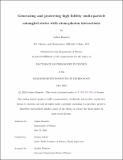Generating and protecting high fidelity multi-particle entangled states with atom-photon interactions
Author(s)
Ramette, Joshua
DownloadThesis PDF (9.938Mb)
Advisor
Vuletić, Vladan
Terms of use
Metadata
Show full item recordAbstract
We introduce methods based on atom-light interactions to produce multi-particle quantum states of atoms. After reviewing the basic challenges associated with engineering atomphoton interactions and techniques for overcoming these, we first describe “counter-factual” carving, a new method that harnesses curious properties of quantum measurements to generate multi-particle entangled states, with potential applications across many quantum information processing systems. With a cavity of cooperativity C used to enhance the atomphoton interaction, counter-factual carving generates entangled states with infidelities of e−C/N, an exponential improvement over previous carving schemes, which scale as [C/N]−1. By fundamentally improving the scaling of the entanglement fidelity with C, it reduces the necessary C for generating high fidelity entangled states by several orders of magnitude in practical scenarios. Next, we consider fault-tolerant quantum computing architectures made from local, error corrected modules linked together via a physically distinct mechanism (such as photonic links) which is generally noisier and slower. Such a modular approach reduces the task of achieving true scalability to designing a unit module of fixed qubit number equipped with a fault-tolerant quantum input/output interface, so that scaling simply involves connecting more identical modules. We show that logical qubits encoded in surface code patches in distinct modules can be fault-tolerantly connected despite substantially elevated noise along their shared interface, helping to solve the crucial problem of network noise inherent when connected error corrected modules to form a modular quantum computer. Then, we consider the full suite of interactions between atoms afforded by Rydberg physics, the exchange (XY) and Ising (ZZ) couplings. By positioning the atoms in a zigzag pattern and applying combinations of microwave photon dressings within the Rydberg manifold, we show how to implement a model Hamiltonian with tunable XY and ZZ couplings between nearest-neighbor and next-nearest-neighbor terms in a 1D spin chain. Tuning these couplings allows one to access a host of interesting phases and quantum phase transitions, including the exotic deconfined quantum criticality (DQC) phenomenon. We introduce methods for using targeted laser exciations to prepare multi-particle ground states of this model Hamiltonian within targeted total magnetization sectors and numerically simulate our procedure at half-filling at points of DQC within the phase diagram. Finally, on a different note, we consider the dynamical behavior of a discrete state coupled to a finite bandwidth quasicontinuum, in the intermediate regime, where the bandwidth of the quasicontinuum cannot be treated as infinite or zero. This problem has many applications, including understanding how to generate an excited Rydberg superatom W state by driving an ensemble of Rydberg atoms initially in their ground states. We consider the driving to be much stronger than the bandwidth and take the small energy spread of the finite bandwidth quasi-continuum as a perturbation on top of the strong drive. Somewhat counter-intuitively, we find that rather than fully decaying into the continuum at long times, the discrete state instead Rabi oscillates into a superposition of the continuum states even at infinite time, following a quick amplitude loss of small magnitude.
Date issued
2024-05Department
Massachusetts Institute of Technology. Department of PhysicsPublisher
Massachusetts Institute of Technology